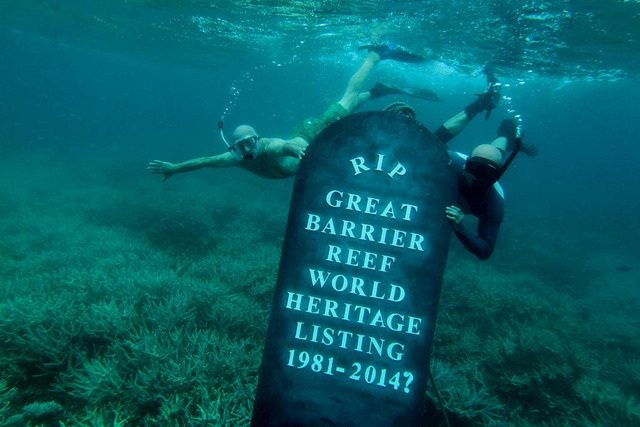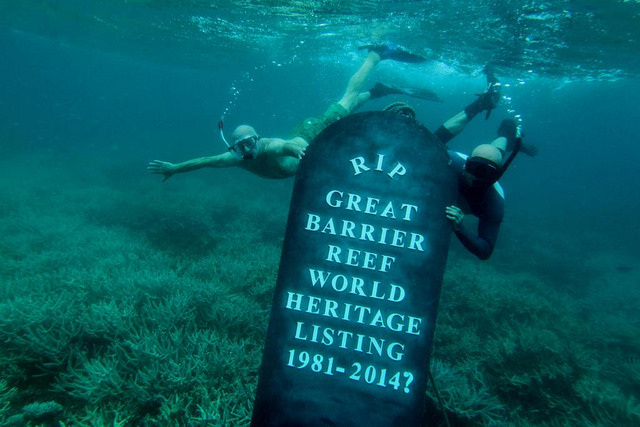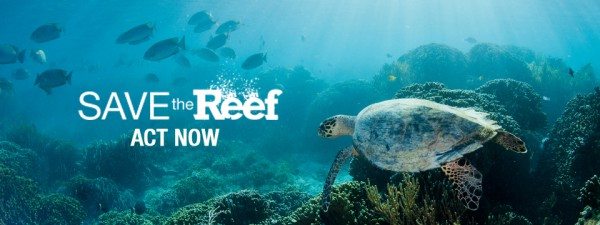The Australian government is running a PR campaign to convince the world that the Great Barrier Reef is fine – most recently inviting international journalists to take a guided tour of the Reef.

With a 50% decline in coral cover since 1985, we reckon there are some important parts of the story they’re leaving out. Here’s what they’re not telling you about our Reef.
Right now, eyes from all around the world are turning to the Great Barrier Reef. In June this year, UNESCO will decide whether or not to place this natural treasure on its official ‘in danger’ list. This is the perfect moment for the Australian government to reject plans for destructive coal port expansions along the Reef. Instead, they’ve opted to launch a global public relations campaign to convince the world the Reef is just fine.
Diplomacy or public relations?
That’s right; instead of working on mitigating clear threats to the Reef like climate change and coal port expansion to avert an ‘in danger listing’, the federal government has spent taxpayer money lobbying UNESCO delegates around the world to convince them that the Great Barrier Reef World Heritage Area is being adequately managed.
Everyone from the Foreign Minister Julie Bishop – who last year claimed the Reef was ‘not in danger’ – to Australian ambassadors, consuls general and other diplomatic staff have been enlisted to campaign. The Australian government has also extended invitations to journalists from countries on the UNESCO World Heritage Committee to tour the Great Barrier Reef with government officials and learn about the government’s conservation efforts.
And now, with the final Reef 2050 report on the long-term plans for protection of the Reef falling short of satisfactory, it’s clear that threats to our Reef are being downplayed.
The report permits two port expansions at the Abbot Point terminal, and fails to fully address cumulative impacts of pressures like mining, shipping, tourism, urban growth, and crown of thorns outbreaks that have already caused an estimated loss of 50% of coral cover. The report says little about plans to mitigate dangerous climate change – despite the fact that the government’s own scientists have deemed it to be the greatest threat to the Reef.
The Reef is fine! Except…
The federal government is spending and talking big to convince you and the world that the Great Barrier Reef is fine. Sure, it’s just fine, if you forget…
1. The Australian government has just approved destructive coal port developments
In 2014, the Australian Government approved a proposal for one of the world’s largest coal mines, Carmichael megamine. To get Carmichael up and running, Indian coal giant and project proponent Adani needs to expand the port at Abbot Point and build a railway from the mine to the port.
Impacts of coal port expansions at Abbot Point include:
- Dredging millions of tonnes of seafloor in the World Heritage Area, destroying habitat for dugongs and snubfin dolphins.
- Hundreds of new coal ships charting through the Reef each year, increasing the risk of oil spills and collisions on the Reef.
- The building of large coal infrastructure at Abbot Point a sensitive area that includes a turtle-nesting site.
Shockingly, the mine, rail and port have already received environmental approvals from the federal government.
2. The Reef has lost half its coral cover in the past 30 years
According to the Great Barrier Reef Marine Park Authority, there has been a 50% decline in coral cover since 1985.
3. Climate change is damaging the Reef
The Australian Government is also ignoring the fact that the increased coal exports from a functioning Carmichael mine will worsen climate change when burnt, intensifying the coral bleaching and ocean acidification processes that could destroy the Reef’s last remaining healthy coral.
4. UNESCO is already worried about the Reef
In 2012, UNESCO threatened to give the Great Barrier Reef World Heritage Area an ‘in danger’ listing unless the Australian Government address key threats facing the Reef, including concerns about proposed coal and gas developments along the Reef coast.
Sadly, both Labor and Liberal – National federal governments have responded with the approval of plans for a massive coal port expansion that will require extensive dredging and send hundreds more coal ships through the Reef each year.
Why does UNESCO’s decision matter?
An ‘in danger’ listing is much more than diplomatic jargon. With the threat of Adani’s Carmichael coal mine, rail line and port project looming over the Great Barrier Reef World Heritage Area – UNESCO’s decision could mean the difference between a Reef left victim to massive coal expansion, or a Reef given the protection it needs.
We don’t want to see our Great Barrier Reef on UNESCO’s ‘in danger’ watchlist – we’d much rather see it adequately protected from industrialisation and climate change. But unfortunately, at this stage, the Australian government simply has not done enough to keep the Reef off the ‘in danger’ list.



